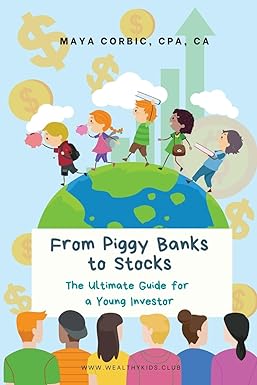
This is a contributed post by Maya Corbic, author of the book From Piggy Banks to Stocks: The Ultimate Guide for a Young Investor and founder of Dinarli Financial Education Academy.
As parents, we strive to instill essential life skills in our teenagers, preparing them for the challenges and opportunities that lie ahead. While we diligently teach them about responsibility, work ethic, and the importance of education, one vital skill often goes overlooked: the basics of investing.
At its core, investing is not just about numbers and financial markets; it’s about building a solid foundation for a prosperous future. Teaching our teens about the benefits of early investing can provide them with a solid financial foundation and set them on the path to financial success.
This article will explore the advantages of investing early for teens, teens’ first lessons in financial education, and the different types of investments available to them.
4 Reasons to Start Your Investment Journey Early in Life
1. The Magic of Compounding
One of the key advantages of investing during the teenage years is the remarkable power of compound interest. By harnessing the long time horizon ahead of them, teens can maximize the potential for their investments to grow exponentially over time. Even a modest amount, when consistently contributed, can turn into a substantial sum thanks to compounding.
2. Building Wealth with Small Contributions
Contrary to popular belief, substantial amounts of money are not a prerequisite for meaningful investments. Even a small weekly contribution can make a significant impact. Let’s consider a scenario where a teen invests just $10 per week from their teenage years until retirement at age 65. With the power of compounding, these consistent contributions can accumulate to an astonishing $2 million or more. Encouraging teens to invest early, regardless of the amount, sets them on the path to financial security and freedom.
3. Time to Recover from Market Volatility
Investing early gives teens a longer time horizon to recover from market downturns or fluctuations. While short-term volatility may cause temporary setbacks, the stock market has historically shown an upward trend over the long term. Educating teens about how the stock market works will empower them to confidently navigate market fluctuations, allowing their investments to recover and potentially grow even stronger.
4. Financial Independence and Freedom
By investing early, teens can work towards achieving financial independence at an earlier stage in their lives. As their investments grow over time, they may have the opportunity to fund their education, start a business, or pursue their passions without relying solely on external sources of funding. This financial freedom empowers them to make choices based on their aspirations rather than financial constraints and sets them up for security in adulthood.
Related: Greenlight Debit Card – Teaching Teens How To Manage Money Made Easy
6 Steps Your Teen Can Take to Begin Investing
To get started on building an investment portfolio, you can guide your teen through the process of opening an online trading account.
Here are the six steps they can follow to ensure they are moving in the right direction:
Step 1: Research and choose an online trading platform.
Multiple online trading platforms are available, each with its own features and benefits. Options such as Vanguard, Fidelity, Charles Schwab, and other offer various advantages. Review and compare factors like fees, types of accounts offered (tax shelters, non-registered trading account, cryptocurrency, etc.), and the types of investments available (stocks, ETFs,etc.)
Step 2: Call and inquire about custodial trading accounts for minors.
Depending on your state, specific age restrictions may apply for opening investment accounts independently. In many states, teens typically need to be at least 18 years of age to open an investment account in their name. However, custodial accounts or youth accounts can be opened for minors with the involvement of a parent or guardian. Check with the brokerages to ensure they provide custodial trading accounts or explore opening an account in your name to manage your child’s investments.
Step 3: Consult with your tax accountant.
Investing has tax implications, so consulting with a tax accountant is wise. Discuss the most advantageous account types based on your tax situation. You have different options such as custodial Roth IRA, 529 plan, or UGMA/UTMA accounts that may be worth considering.
Step 4: Open the recommended account.
Return to the online trading platform and open the account recommended by your tax accountant. The account setup process is typically straightforward. During this process, you’ll be asked to provide personal information, such as your name, address, social security number, or other identifying details.
Step 5: Connect your bank account to your trading account.
Link your bank account to the trading platform to facilitate seamless investment fund transfers. Some platforms allow multiple bank accounts for added flexibility and convenience.
Step 6: Consider using an investment advisor or a robo advisor.
The above examples assume that you will be opening the account and managing investments by yourself. However, you can always hire a financial advisor or a robo-advisor. An investment advisor is a professional who for a fee provides investment advice based on your investment goals, risk tolerance, and other factors and will help your teen make the right investments for their future.
Robo-advisor is an artificial intelligence that for a fee collects information about you via an online survey and then asks you questions to help you choose investing platforms that would benefit you.
Related: How To Teach Teens To Budget And Why It Is So Important
Don’t Wait! Teach Your Teen About Financial Literacy and Investing Now
Teaching kids to be young investors equips them with a valuable life skill that significantly impacts their financial future. Remember, it’s better to start sooner rather than later. Empowering our teens to take ownership over their investment choices lays the foundation for a lifetime of financial success and security.
For more tips and resources on helping your teenager with their investment portfolio and becoming financially literate, we recommend Maya Corbic’s book From Piggy Banks to Stocks: The Ultimate Guide for a Young Investor. In this book geared toward kids and teens, Maya Corbic empowers your child with financial wisdom, makes investing exciting, and helps kids pursue their path of financial freedom.

Parenting teens and tweens is a tough job, but you’re not alone. Here are some popular posts that other parents have found helpful:
How To Make Sure You Raise A Teen With Good Money Management Skills
10 Simple Ways Parents Can Help Their Teens with Executive Function Skills
10 Must-Listen To Podcasts for Parents of Teens
9 Ways Parents Can Help Their Child Build Executive Function in Middle School
*This post may contain affiliate links where we earn a small commission for purchases made from our site.





Leave a Comment